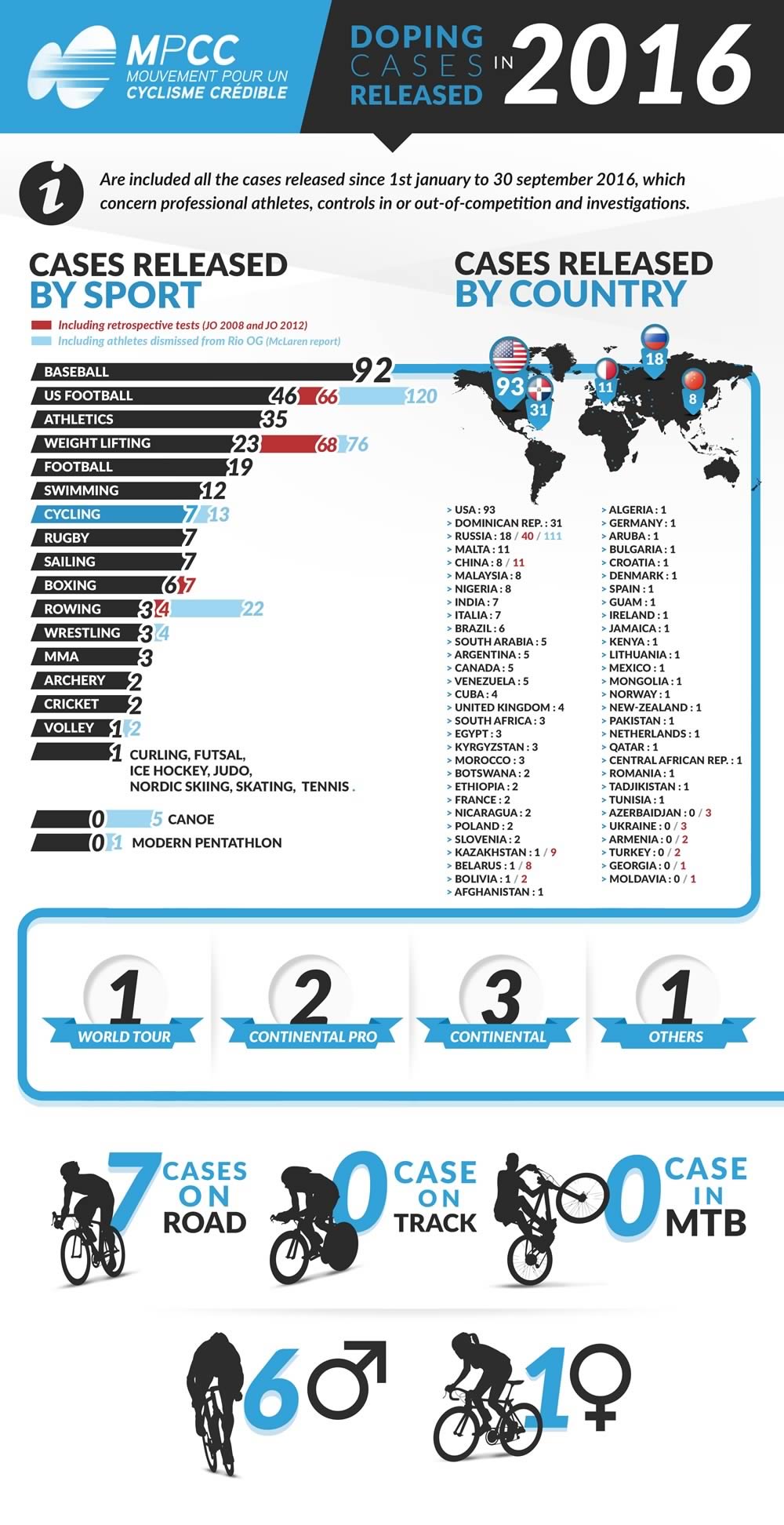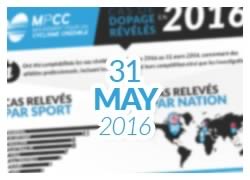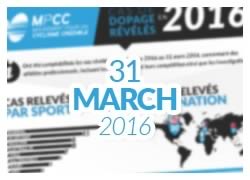That is unprecedented: since the beginning of the year, a baseball player has been busted every three days. Thanks to the headlines focusing on the Russian athletes suspected of doping, the fact has remained unnoticed. Our quarterly infography is made to highlight that the figures actually collected aren’t the illustration of the scandals with a high impact on the media.
Today there is no simple way to collect the figures of the doping cases released accross the world. To paint a credible picture of the fight against doping, we had to deal with some events that sometimes were subject to contradiction within the whole olympic “family”. For various reasons:
– prohibition of the use of the Meldonium since 1 January 2016 ;
– retrospective tests of 2008 Beijing and 2012 London OGs’ samples ;
– WADA’s decision to dissmiss many Russian athletes from 2016 Rio OGs because of the suspected organized doping spotted by the McLaren report.
The particular case of Meldonium
We have made the decision not to include those Meldonium positive tests released at the beginning of the year. The reason is that as early as the spring, WADA stated that the medication was not eliminated of the urine on the basis of a reliable period. In an important number of cases, that means we cannot demonstrate the Meldonium would have been taken in 2016 and not in 2015.
330 athletes – mostly from Eastern Europe – had been provisionally suspended for Meldonium use. The majority of them have since received from their respective federations the authorization to resume competition. To date, we cannot ensure a signifiant share of the open procedures will lead to actual sanctions. This applies to, amongst others, the three Russian cyclists involved in Meldonium cases.
We have however included in our table the high-profile case of Maria Sharapova because her 2-years ban – then reduced to 15 months by the CAS – has been officialy expressed by the ITF. In her very first statements, the tennis player admitted she was still under Meldonium treatment at the beginning of 2016. To public knowledge, she today remains the only athlete under a ban for a use of Meldonium (which will stay on the 2017 WADA’s list of prohibited substances).
The Russian athletes out of Rio Olympic Games
On the other hand, we wanted to see in our infography (blue figures) the 111 McLaren-reported Russian athletes who have been dismissed from the Rio OGs from their respective sporting federations. We have to make it clear that not all of those exclusions led to disciplinary sanctions against involved athletes. Some of them had been dismissed from the OGs on the grounds that they had already been banned for earlier doping facts.
To quote a recent declaration from the report author Richard McLaren, who recently clarified that he would need several additional months to draft the final document: “This second phase focuses on the information regarding the athlete”. The Canadian jurist also said he intends to provide this information to the federations.
Beijing and London samples reanalyzeD
If we focus on the 2008 Beijing and 2012 London samples reanalyzed by WADA, Russia is still the most affected nation. Among these retrospective tests (covering 1,200 samples), 98 positive results have been detected including 55 directly named athletes. These cases are highlighted in red in our infography. 43 subject-to-discretion cases remain: we don’t know who are the concerned athletes, nor even which sports they are related to.
That is unfortunate because MPCC sees transparency as a guarantee of credibility in terms of fight against doping engaged by the international federations. Cycling is a very good example. It has the kind of behaviour our movement encourages: the UCI publishes all the provisional or definitive sanctions it imposes.
The major trends
The McLaren report thus brought Russia’s suspected organized doping to light. But this scandal, too exposed by the media in a pre-olympic period, may have masked the fact that a major health problem also affected the American leagues. It has been a few years since the MLB strengthened his anti-doping policy by developing a toolbox of sanctions. It is symptomatic that the amount of disciplinary procedures hasn’t stop increasing for 7 years, but also that for the very first time in MLB history, a player has been banned for life because of a third infraction in a row. Baseball is sufficient to make both United States and Dominican Republic the two most affected nation per positive tests.
Today it seems the NFL wants to follow the steps of the baseball league by implementing a program which weakness is the non-dissuasive penalty system. An athlete busted for the first time is suspended for 4 games. For the second time, the sanction ups to… 10 games! There is so much more we could say about the NHL (which includes 800 professional players): in a decade, only 4 doping cases touched this league!
Yet it is not unlikely that Russia may catch and drop the leading group when the McLaren final report will finally be released. The three sports which centralise the most suspicions – rowing, weightlifting, athletics – are very practiced at high level by Russian athletes. Athletics is the most denatured sport into the olympic landscape even if the number of positives tests is decreasing in 2016 – it was already the case in 2015. The decrease is the same for cycling. Both in 2014 and 2015, our sport faced about fifteen cases per year, classified itself in the 4th position of our table. This year, cycling is 7th with only 7 released cases. But it is going to to take three more months before stating the confirmation of this momentum.
TAKE A LOOK AT OUR doping cases INFOGRAPHY

TAKE A LOOK AT THE INFOGRAPHIES AS OF 31 MARCH AND 31 MAY


